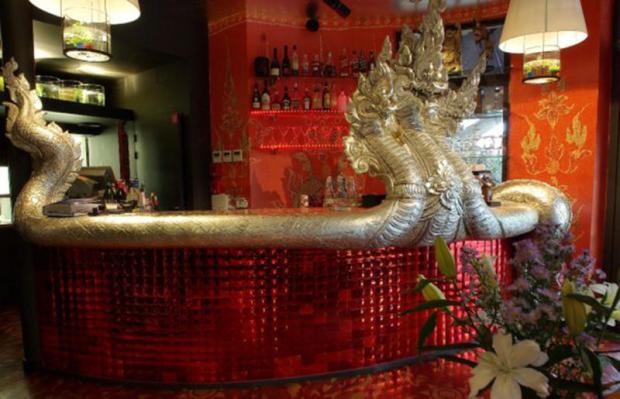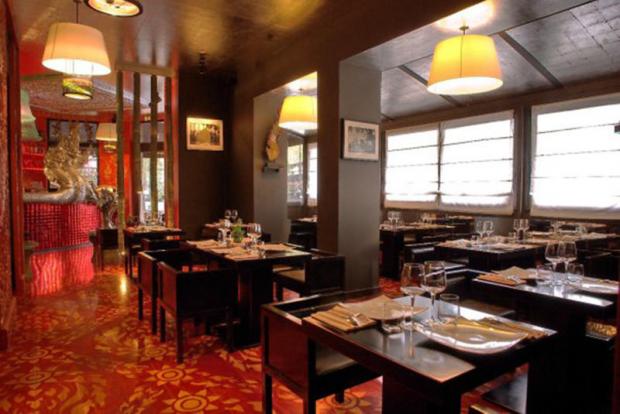'Life can be designed with one's own hands, but opportunities make it easier," says Oth Sombat as he puts the finishing touches to a tempting plate of shrimp rice vermicelli.

Three nagas, after which the restaurant is named, adorn the bar area which is lavishly decorated with oriental motifs.
Creating this kind of Thai fusion cuisine and other signature dishes has put the Mukdahan-born Oth and his restaurant in the heart of Paris on the gastronomic map.
Made of obsiblue prawns − the rare and sweet blue crustacean − rice vermicelli and emulsified phak chee lao (dill) dressing, the dish screams extravagance and demonstrates how Thai food has morphed into fine dining at the exclusive Aux Trois Nagas restaurant.
There, the common ingredients in Thai food are brought together to spring a perfect blend of taste and presentation, which alludes to the life of the chef himself.
Mr Oth, known as Chef Oth, has made it big in Paris. It wasn't that long ago that the humble son of a small-scale farmer from Mukdahan was adopted by Lao parents who took the family to Brussels, where Mr Oth's gastronomic innovation and creativity for cooking began to shine.
Mr Oth, who is now in his mid 30s, pauses when asked to speak about his childhood and his advancement in the kitchen of a top-class restaurant in one of the world's great cuisine capitals.
"I was born in Mukdahan to a farming family. My [biological] parents had a rice farm where I frequently took the buffaloes [for ploughing and raising]," he said, adding he did not think seriously about his future until he reached a "turning point in his life at 15 years of age".
"My parents have Lao friends. They are a couple and occasionally visited my family. One day my parents told me that they wanted to adopt me because they do not have a son. They only have daughters," he said.
The adoption did not bother him as much as the fact that he would have to leave Thailand as his new family planned to resettle for a better life. The family first applied for US citizenship but failed after an interview.
They then looked to Europe, and Belgium granted them residency. The whole family packed their suitcases and flew off to a country they knew very little about.
Before getting on the plane, Mr Oth, still 15, made a parting joke: "I left Thailand with 20 baht in my pocket."
He said he did not want to be away from his biological parents in a strange, unknown land. But the prospect of a brighter future in Europe and the Lao couple's assurance that he would be well-taken care of made him decide to accept migration to Belgium.
His life in Belgium started out on a happy note. He enrolled at a vocational school, studying mechanics and engineering. However, working with machines was not his calling.
His passion lay elsewhere and becoming a master gourmet was his aim. Mr Oth lost no time switching to cookery school.
After graduation, he worked in the kitchens of several restaurants and realised his roots in Thai food were his strength. He got his big break when he landed the job of head chief at the Aux Trois Nagas in Paris.
But to thrive in the stiffly competitive environment of Paris, Mr Oth knew he had to innovate and re-invent Thai food so that it not only tastes good but also looks inviting.
He created a line of Thai fusion dishes using authentic ingredients and fresh produce which even some new-generation Thais are not familiar with, such as phak paew leafs usually tossed into larb dishes.
What is served matters in equal measure as how the food is plated up. It must be nothing short of exquisite to win over well-heeled crowds with sophisticated palates.
The presentation of the dishes resembles elegant Western menus but with the distinctive tastes of popular Thai dishes.
His creative execution of the dishes has earned him applause, which in turn has led to him being invited to demonstrate Thai cooking at the prestigious food and beverage exhibition, the SIAL 2014, in Paris. His show attracted many participants.
Back at the Aux Trois Nagas on the Avenue du Président Kennedy, Mr Oth said he also worked in a restaurant in Brussels, his adopted home city, and commutes for about an hour and a half to the Aux Trois Nagas.
His career was launched in 1984 at the famous Blue Elephant Thai restaurant in Brussels, where he was apprenticed. He progressed from entry-level cuisiner to chief de cuisine and chief executive. He quit the Blue Elephant in 1997 to create his own menus.
"I don't want to stick to the same pattern of food. Food or cuisine is like art. It has to be cooked in creative ways and customers can enjoy it with unrestrained pleasure," he said.
Chef Oth explained that the art of eating with pleasure covers "three goods" − good look, good smell and good quality.
"Generally if food is served in a beautiful composition on the plate, we are more tempted to eat it. Next step is smell, followed by chewing to taste the food," he said.
One of the signature dishes at the Aux Troi Nagas is the grilled beef seua rong hai, which is in high demand among foreign and Thai diners. Seua rong hai is a medium grilled beef with a sharp dipping source served with vegetables and sticky rice.
But Mr Oth's version is no ordinary seua rong hai.
"We need to make it into a delicacy. I cut the grilled beef into a medallion with a succulent centre. I always mix coconut milk with the sticky rice to make it soft and serve the dish with somtam and a spicy Isan dip [jaew]," he said.
"Being a chef in Paris, or even in Brussels, is not easy since the customers here frequently call the chef over to their tables to explain about the food. It is exciting for me," he said.
Another dish he has re-created is kaengped ped yang (roast duck in red curry). Mr Oth said the conventional appearance of the Thai curry dish needs a new twist.
"I came up with the idea to grill the duck meat like a steak and set it aside on the plate. Then I fried a ball of batter with the red curry gravy inside it. When you cut into the ball, the kaeng phed gravy will ooze out and mix with the duck," he said.
Other mainstay dishes that have customers clamouring for more are pla neung manaow, phad thai and tom kha gai. Mr Oth said with the tom kha gai (chicken in coconut soup with galangal), the soup is turned into a soft cream but still retains the unique taste and extraordinary scent of the galangal.
However, he has adopted methods to tone down the naturally heavily pungent smell of some ingredients so that European customers are not overwhelmed by it.
There are many fine-dining Thai restaurants in Paris and the competition is high, he says. Therefore, innovation is very important to stand tall in the Paris restaurant scene. "That is why I have to think about new forms of Thai cuisine every day."
The Lao owner of Aux Trois Nagas, Subinh Prasith, agrees with his chef, saying the unique recipes prompt customers to call Mr Oth out of the kitchen for a chat.
"When I ate Thai food during a reception at the Thai embassy in Paris one evening, I asked people who had cooked the food − and that got me thinking that I should open a restaurant," he said.
Mr Oth said he has his own theories of cooking and likes to experiment.
"I'm so proud of Thai food. I always use ingredients from Thailand that we can find here in Paris,'' he said.







